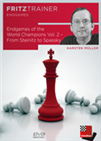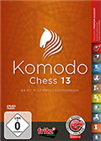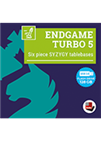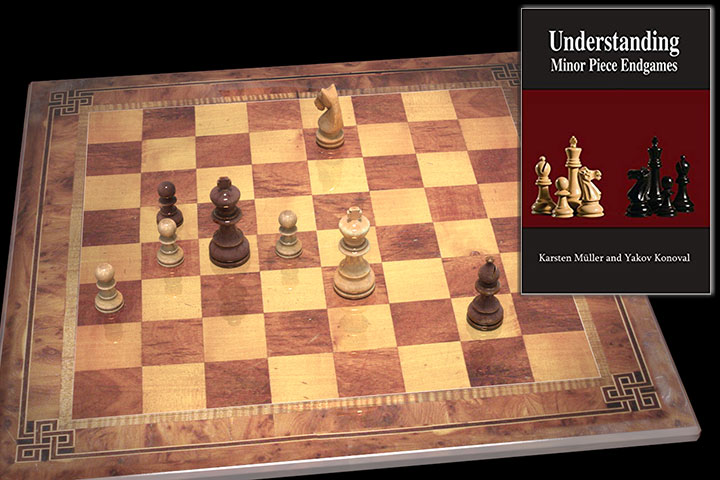In Chess Endgame News...
Review by Guy Haworth
‘UME’ will be eagerly snapped up by professional players but it is also accessible to club players and enthusiasts such as myself. This book combines the insight and enthusiasm of the well-known and prolific endgame expert with the technical precision of Yakov Konoval’s sub-8-man ‘DTC’ Depth to Conversion endgame tables. ‘Man and machine’ is an excellent combination and this is one of its finer feats of inexorable logic. It is both informative and entertaining, certainly a worthy successor to Understanding Rook Endgames (Müller and Konoval, 2016). The board has no queens or rooks but sports at least one minor piece on the board: no side has more than one. The core domain ranges from KNKP to KXPPKX¢P — where X and X¢ are B, N or P.
 Demis Hassabis once opined (Sadler and Regan, 2019) that it is “the exquisite balance of the bishop and knight across the set of all positions, despite their vastly different mobility, that creates the dynamic tension in the game”. Here, the book builds to Chapter 6, some 40% of the whole, where finally, spiritual and temporal, bishop and knight, face off against each other. In preparation, we study the single knight against foot soldiers (ch. 1), the joust of knight against knight (ch. 2), the sole bishop (ch. 3) and the ecclesiastical struggle of bishop against bishop, whether in the same church on the same-colour squares (ch. 4) or not (ch. 5). The drawish opposite-coloured bishop situations, incidentally, seem to be enjoyed by AlphaZero.
Demis Hassabis once opined (Sadler and Regan, 2019) that it is “the exquisite balance of the bishop and knight across the set of all positions, despite their vastly different mobility, that creates the dynamic tension in the game”. Here, the book builds to Chapter 6, some 40% of the whole, where finally, spiritual and temporal, bishop and knight, face off against each other. In preparation, we study the single knight against foot soldiers (ch. 1), the joust of knight against knight (ch. 2), the sole bishop (ch. 3) and the ecclesiastical struggle of bishop against bishop, whether in the same church on the same-colour squares (ch. 4) or not (ch. 5). The drawish opposite-coloured bishop situations, incidentally, seem to be enjoyed by AlphaZero.
The finer structure is clear, once laid out, but it takes a mathematical, rigorous and perceptive mind like Karsten’s to realize what that structure should be. Beyond the focusing on specific endgames, the key characteristics and themes of each subdomain are defined and guide one’s understanding. Pawns may be on specific files, may or may not be close, connected or ‘passed’, a minor piece may (not) have the advantage, bishops do (not) control the queening square etc. The contents list could perhaps have usefully gone one or two levels deeper than the chapter headings.
The many examples — over 500 of them — tend to focus on but are not limited to sub-8-man positions. Here, you will find the skill and artistry of many World Champions on display and sometimes they face each other: only Tigran Petrosian is missing from the line of succession. Here are a couple of the famous and/or complex gems.
 Enjoy Capablanca's fine technique, Tal's magic, Lasker's fighting spirit, Petrosian's defensive skills, Smyslov's feeling for harmony, and Alekhine's and Spassky's flair for the attack.
Enjoy Capablanca's fine technique, Tal's magic, Lasker's fighting spirit, Petrosian's defensive skills, Smyslov's feeling for harmony, and Alekhine's and Spassky's flair for the attack.The corpus of didactic positions and chess studies also provides material. Some 340 ‘game’ exercises and 46 pages of solutions also help to check our understanding of the various points made. Here's a small selection for the reader.
You can take a stab at the positions on the diagrams, and then review the solutions in the full-sized game viewer below. Some broad hints are provided to the exercises and studies if you click or tap the hint button (life preserver icon).
 Komodo 13 thinks like no other chess program. Inspired by AlphaZero, Komodo developers GM Larry Kaufman and Mark Lefler have reinvented their engine from scratch over the last two years. The result speaks for itself: The new Komodo 13 MCTS ("Monte Carlo Tree Search") searches for candidate moves in an incredibly innovative way and finds solutions most engines never see!
Komodo 13 thinks like no other chess program. Inspired by AlphaZero, Komodo developers GM Larry Kaufman and Mark Lefler have reinvented their engine from scratch over the last two years. The result speaks for itself: The new Komodo 13 MCTS ("Monte Carlo Tree Search") searches for candidate moves in an incredibly innovative way and finds solutions most engines never see!Chapter 8 merely picks up on a few studies which have been cooked or corrected en passant. Chapter 7 touches on some opportunities missed by chess engines, ‘limited’ or at least challenged as they currently are by ‘the curse of the knight’ zugzwang positions, their search-horizons and by ‘only’ having 6-man ‘EGT’ endgame tables. The now prominent Chiron (#8), Fire (#23), Houdini, (#5/26), Rybka (#21), Komodo (#6/7/12), Shredder (#10/11) and Stockfish (#16/18) all have their moments in the shade, but they are older, wiser and better informed now.
Nearly forty ‘longest-DTC wins’ show the full complexity of the various endgames, many of the lines being usefully commentated on. Endgame aficionados will also enjoy looking at the lines in the context of EGTs to metrics other than Konoval’s ‘DTC’ Depth to Conversion. The Lomonosov (2012) DTM(ate) EGTs are now joined by the equally extensive and popular ‘depth to plycount zeroing’ DTZ50 EGTs which take into account the 50-move rule (de Man et al, 2018). Deep lines to different depth metrics can eventually diverge as they are pulled in different directions by their specific objectives. For example, do the three frustrated wins (#2.47A KNPPknp, #3.66 KBPkppp and #6.178 KNPPknp) let go of their 50-move-rule defence because of the given DTC-centric lines? Do the DTM- and DTC-minimaxing lines diverge and if so, where? What can be learned at the branch-point?
 Perfect endgame analysis and a huge increase in engine performance: Get it with the new Endgame Turbo 5! This brings the full 6-piece Syzygy endgame tablebases on a pendrive. Just plug it in a USB socket and you are set!
Perfect endgame analysis and a huge increase in engine performance: Get it with the new Endgame Turbo 5! This brings the full 6-piece Syzygy endgame tablebases on a pendrive. Just plug it in a USB socket and you are set!The maxDTC-deepest 'UME' endgames, both 1-0
Müller and Konoval have produced a definitive work here in UME, mastering a large subject with authority and organizing it so that it is more accessible to the greater chess community. The result is attractive, fascinating, instructive, enriching — entirely as one would expect from this team. It is a pleasure to see items of beautiful glassware being skilfully drawn from the silica of endgame data.
References
- de Man, R., Fiekas, N. and Guo, B. (2018). https://tinyurl.com/icga007. Fiekas’ interface to ‘Syzygy formatted’ de Man sub-7-man and Guo 7-man DTZ50² EGTs.
- Haworth, G. McC. (2019). http://centaur.reading.ac.uk/82423/. This item plus supplementary data on content, longest wins etc.
- Lomonosov (2012). http://tb7.chessok.com/. Query interface to sub-8-man DTM EGTs.
- Müller, K. and Konoval, Y. (2016). Understanding Rook Endgames. Gambit.
- Müller, K. and Konoval, Y. (2019). Understanding Minor Piece Endgames. Russell Enterprises.
- Sadler, M. and Regan, N. (2019). Game Changer. New in Chess.
Links


















 Demis Hassabis once opined (Sadler and Regan, 2019) that it is “the exquisite balance of the bishop and knight across the set of all positions, despite their vastly different mobility, that creates the dynamic tension in the game”. Here, the book builds to Chapter 6, some 40% of the whole, where finally, spiritual and temporal, bishop and knight, face off against each other. In preparation, we study the single knight against foot soldiers (ch. 1), the joust of knight against knight (ch. 2), the sole bishop (ch. 3) and the ecclesiastical struggle of bishop against bishop, whether in the same church on the same-colour squares (ch. 4) or not (ch. 5). The drawish opposite-coloured bishop situations, incidentally, seem to be enjoyed by
Demis Hassabis once opined (Sadler and Regan, 2019) that it is “the exquisite balance of the bishop and knight across the set of all positions, despite their vastly different mobility, that creates the dynamic tension in the game”. Here, the book builds to Chapter 6, some 40% of the whole, where finally, spiritual and temporal, bishop and knight, face off against each other. In preparation, we study the single knight against foot soldiers (ch. 1), the joust of knight against knight (ch. 2), the sole bishop (ch. 3) and the ecclesiastical struggle of bishop against bishop, whether in the same church on the same-colour squares (ch. 4) or not (ch. 5). The drawish opposite-coloured bishop situations, incidentally, seem to be enjoyed by 




